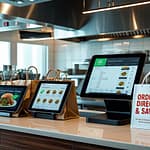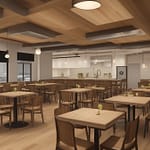Key Takeaways:
- Ensure your restaurant website has a clear, easy-to-navigate layout to improve user experience (UX).
- Include high-quality photos of your menu items to entice potential customers.
- Implement online reservation and ordering systems to increase conversion rates.
- Regularly update your website with the latest menu, events, and special promotions to keep customers engaged.
- Avoid using excessive pop-ups or ads that can deter visitors from staying on your website.
Top Restaurant Website Mistakes (And How to Fix Them Fast)
Avoid common web errors that lose customers
Your restaurant website is often the first impression potential diners have of your business. Unfortunately, many restaurants unknowingly sabotage their online presence with common mistakes that frustrate visitors and drive them away. In today’s digital age, customers expect seamless navigation, quick access to menus, and a smooth reservation process. When these elements aren’t met, your restaurant risks losing potential patrons before they’ve even set foot in your establishment.
But don’t worry—identifying and correcting these common restaurant website missteps can significantly enhance user experience, improve customer retention, and boost your overall sales. Let’s explore the most common errors restaurants make online and outline practical, actionable tips you can implement immediately.
Mistake #1: Slow Loading Times
In a fast-paced digital world, patience is scarce. Customers expect restaurant websites to load quickly, typically within two to three seconds. If your site takes too long, you risk visitors abandoning your page in frustration, potentially leading them straight to your competitors.
How to Fix It
- Optimize images: Large, uncompressed images significantly slow down your website. Compress images using online tools like TinyPNG or JPEG Optimizer before uploading them.
- Choose a reliable host: Ensure your web hosting service delivers fast load times and minimal downtime. Investing in quality hosting can dramatically improve site speed.
- Minimize plugins and scripts: Remove unnecessary plugins, widgets, and scripts that clutter your site and slow performance.
Mistake #2: Confusing or Hidden Menus
Customers visit restaurant websites primarily to view menus and pricing. A menu that’s difficult to find, outdated, or hard to navigate frustrates users and weakens your credibility. Additionally, menus in PDF format or images that require downloading deter visitors from exploring your offerings.
How to Fix It
- Place menus prominently: Feature your menu clearly and prominently on your homepage or navigation bar.
- Use HTML-based menus: Avoid PDF-only menus; instead, use responsive, mobile-friendly HTML menus that load quickly and are easy to read on any device.
- Ensure information is current: Regularly update your menus with accurate pricing, seasonal items, and specials to keep your website professional and trustworthy.
Industry Example
Consider the popular restaurant chain Chipotle. Their website prominently places the menu link at the top navigation bar, offering clear, concise categories that customers can quickly browse. This simple yet effective design enhances the user experience and encourages customers to make quicker decisions.
Mistake #3: Poor Mobile Experience
More than half of all restaurant website traffic now comes from mobile devices. Having a website that doesn’t display correctly on smartphones or tablets is a major oversight. Customers who struggle with awkward scrolling, tiny text, or unresponsive elements will quickly move on.
How to Fix It
- Adopt responsive design: Ensure your website automatically adjusts to fit any screen size, providing seamless navigation and readability.
- Test on multiple devices: Regularly test your website on various mobile devices and screen sizes to guarantee consistent performance.
- Simplify navigation: Streamline your mobile site by simplifying menus, reducing clutter, and making important information readily accessible.
Mistake #4: Missing or Difficult Reservation System
Diners increasingly prefer booking reservations online rather than calling or visiting in person. Restaurants lacking an easy-to-use reservation system lose out on potential bookings and revenue.
How to Fix It
- Implement online reservations: Use reservation platforms like OpenTable, Resy, or Tock, embedding their seamless booking widgets into your website.
- Clearly display reservation options: Place reservation buttons or links prominently on your homepage and navigation bar, making it simple for guests to book.
- Send confirmation emails: Ensure your reservation system provides automated confirmation emails or texts, reducing confusion and no-shows.
Industry Example
Fine-dining establishments like Ruth’s Chris Steak House effectively use reservation platforms to streamline the booking process. Their website integrates an easy-to-find reservation widget, allowing guests to select available dates and times effortlessly, enhancing convenience and boosting bookings.
Mistake #5: Lack of Essential Information
Customers visiting restaurant websites typically look for basic information like location, hours of operation, and contact details. Missing or difficult-to-find information can frustrate users and drive them to competitors.
How to Fix It
- Create a clear contact section: Dedicate a clear section on your homepage or footer with your restaurant’s address, phone number, email, and business hours.
- Include directions and maps: Embed Google Maps or provide clear directions to simplify navigation for first-time visitors.
- Keep details updated: Regularly verify and update your website with accurate operational hours and contact information, especially during holidays or special events.
Mistake #6: Ignoring SEO Best Practices
Even the most beautifully designed restaurant websites fail if potential customers can’t find them through search engines. Ignoring basic SEO practices means your restaurant may not appear in local searches, resulting in lost business opportunities.
How to Fix It
- Use relevant keywords: Incorporate targeted local keywords throughout your website content, including your menu, descriptions, and headers.
- Optimize your site structure: Ensure your site’s navigation and internal links are clear and structured logically to help users and search engines alike.
- Claim your Google Business Profile: Keep your Google Business Profile accurate, complete, and updated, significantly improving your visibility in local searches.
Industry Example
Local restaurants successfully leveraging SEO see significant online visibility boosts. For instance, a small bistro in Seattle optimized its website for local search terms and saw a 40% increase in online reservations and foot traffic within three months.
Mistake #7: Neglecting Online Reviews and Testimonials
Potential customers rely heavily on reviews and testimonials to guide their dining decisions. Websites lacking positive reviews or testimonials appear less trustworthy, discouraging potential diners from visiting your establishment.
How to Fix It
- Showcase positive reviews: Feature genuine customer testimonials prominently on your homepage or dedicated testimonials page.
- Encourage more reviews: Proactively ask satisfied customers to share their experiences online, both on your website and popular review platforms like Yelp or Google.
- Respond promptly: Monitor and respond professionally to negative reviews, demonstrating your commitment to customer satisfaction.
Conclusion
Your restaurant website is a powerful tool for attracting new customers, building loyalty, and increasing revenue. By recognizing and correcting common UX issues and conversion pitfalls—like slow loading times, confusing menus, poor mobile experience, and lack of a clear reservation system—you can significantly enhance your online presence and customer experience. Implement these actionable fixes today, and ensure your restaurant website effectively supports your business goals and delights potential diners at every click.






Comments
Be the first to comment on this article.